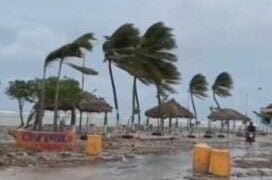As voters exercise their rights across the United States in the 2024 presidential election, reports of extreme weather and temporary infrastructure disruptions have surfaced in various regions.
However, a top federal cybersecurity official reassured the public that the incidents were not posing any significant threat to the overall security of the election infrastructure.
“We are tracking instances of extreme weather and other temporary infrastructure disruptions in certain areas of the country, but these are largely expected, routine, and planned-for events,” a senior adviser at the Cybersecurity and Infrastructure Security Agency (CISA), Cait Conley, said during a press briefing on Tuesday morning.
While the disruptions have been noted, Conley stressed that there have been no “national-level significant incidents impacting the security of our election infrastructure.”
Conley didn’t specify the exact locations where the local disruptions occurred, however, he emphasised that they are part of the expected challenges that often arise during elections.
Such disruptions, she said, include temporary power outages or issues related to transportation that could affect polling stations or the movement of election materials.
LEADERSHIP gathered that some key battleground states were hit by a strong cold front, bringing heavy rainfall and severe storms.
Wisconsin, one of the crucial swing states, appeared to be facing the worst of the weather, with heavy rain and a potential for severe storms impacting voter turnout and election day operations.
The Storm Prediction Center has issued a level 1 out of 5 severe storm threat for much of Wisconsin, adding to concerns about how extreme weather may affect the election process in these areas.
In addition to Wisconsin, other battleground states are also experiencing varying degrees of weather-related challenges, including rain and high winds that could complicate travel for voters.
Despite the weather disruptions, local election officials have prepared for such challenges and are deploying contingency plans to minimize their impact on voting, this includes ensuring that voting machines and infrastructure are protected from weather-related issues and adjusting voting hours if necessary to accommodate delays.





